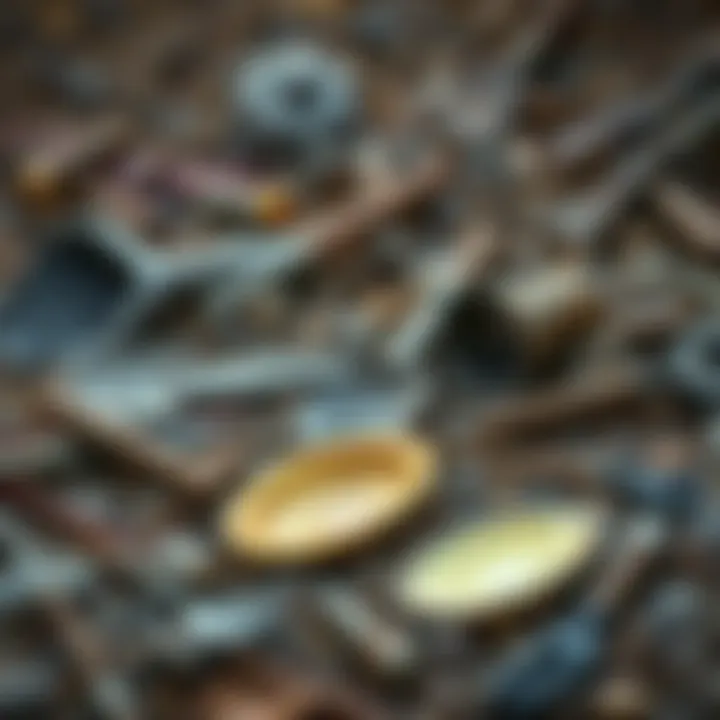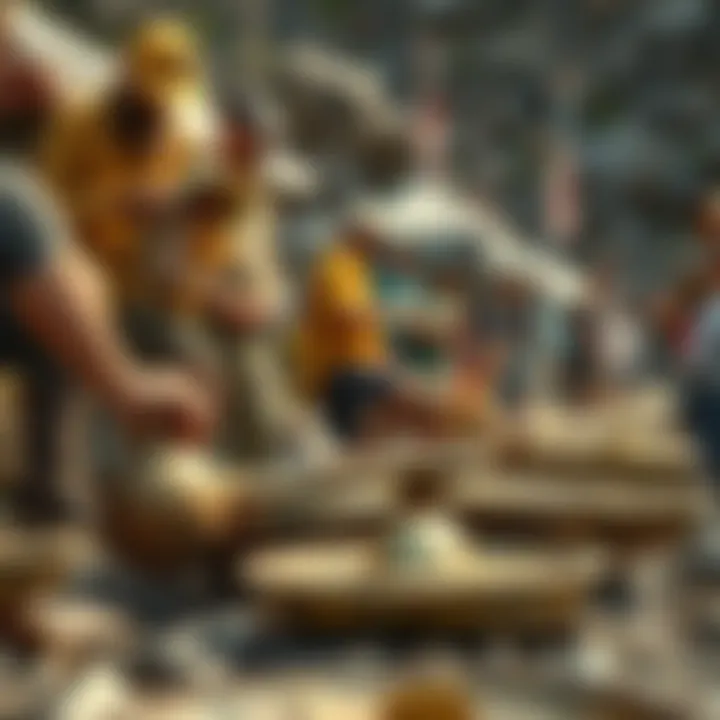Mastering the Art of Gold Panning Techniques


Intro
In a world that’s increasingly digital, the idea of striking gold with just a pan and some water feels like a throwback to simpler times. The dance of clear water over a riverbed, the gentle splash as earth is sifted and the thrill of finding that glint of gold beneath the muck, gold panning offers a blend of adventure, history and community. This article will explore the nuts and bolts of this deeply-rooted craft, shedding light on techniques, tools, and the camaraderie that often finds its way into the hobby.
History and Origins
Gold panning isn’t just a method for separating precious metal from dirt; it’s a story of exploration, survival, and the insatiable human desire to find value in nature. From the idyllic streams of California during the Gold Rush to the rivers in Australia and beyond, the act of manually panning for gold has shaped communities and economies.
Overview of Collectibles, Rocks, and Fossils
The allure of gold extends into the broader realm of collecting. While many are drawn purely to the prospect of riches, others find the beauty in the full experience of nature: the rocks, fossils, and remnants of ancient life that can accompany a day of panning. Picture this: each stone tells a story, carrying hints from aeons past that intrigue geologists and treasure hunters alike.
Historical Significance and Cultural Impact
Gold panning has a rich and vibrant history. In the mid-1800s, it played a crucial role in the growth of many American towns. Pioneers flocked to places such as Sutter's Mill in California, forever altering the landscape and society. Beyond mere extraction, it symbolizes human aspiration and resilience. Communities formed, not just around the promise of gold, but also through the shared experiences of labor, discovery, and, at times, hardship.
Gold panners often become part of a thriving subculture. They swap tips, celebrate finds, and bond over common interests. Whether it’s at a local gold rush reenactment or an online forum like Reddit, these enthusiasts exchange knowledge that helps preserve this craft and its deeply interwoven legacies.
Identification and Classification
Once you dive into the realm of gold panning, you find yourself facing not just water and sand, but a myriad of rock classifications and collectibles. To become a proficient gold panner, understanding what lies beneath the surface is essential.
Guide to Identifying Rocks and Fossils
When you’re out by the river, recognizing the various rocks can enhance your panning experience. Common types can include:
- Igneous Rocks: Formed through volcanic activity, these rocks can have traces of precious minerals.
- Sedimentary Rocks: Often layered and may contain fossil remnants, hinting at the geological history.
- Metamorphic Rocks: Altered under pressure, reflecting a different chapter in Earth’s story.
Common Types and Variations
Gold itself comes in various forms that can be classified as:
- Nuggets: Larger pieces, often found in heavier sediment.
- Flakes: Smaller bits that can easily be lost unless carefully sifted through.
- Flecks: Tiny particles that can elude the untrained eye, but are nevertheless worth the effort to collect.
The process of learning these variations not only improves your skills but opens doors to discussions with other collectors and panners. Engaging with experts or fellow hobbyists, whether at a local park or through educational resources, will truly deepen your connection to the earth beneath your feet.
"A well-informed collector holds not only treasures but also stories of history, geology, and the collective journey of humankind through its adventures in nature."
In closing, gold panning serves as a bridge – linking the past with the present, while inviting participants to connect with the earth and each other. As we dive deeper into techniques and equipment, remember that each pan tells a unique tale, waiting for you to discover.
Prologue to Gold Panning
Gold panning represents a fascinating intersection of craft, adventure, and history. It's not just about standing by a river and waiting for that shiny nugget to appear; it's about the process, the ritual, and the connection to nature. This practice beckons enthusiasts from all walks of life, urging them to immerse themselves in the simplicity yet profound nature of rock and fossil collecting.
The allure of gold panning is often tied to its historical significance, echoing tales of fortune seekers and ambitious prospectors who sought their dreams in the streams and rivers of old. Understanding this art form enriches the experience for both novices and seasoned collectors, adding a layer of context that transforms a simple hobby into a meaningful pursuit.
While anyone can hop into a river with a pan, mastering the techniques involved is what elevates the experience. The nuances of how to differentiate between heavy mineral deposits and actual gold, or knowing when and where to scout for ideal panning sites, define a successful day on the water. Each technique, whether it involves the angle of the pan or the choice of location, contributes to one's proficiency.
Moreover, gold panning is more than just a treasure hunt; it fosters connections with like-minded individuals. It's not uncommon to find communities built around this hobby where tips, tricks, and stories are shared—from the novice learning the ropes to the veteran sharing time-honored expertise. As you delve into this guide, you'll not only learn about the techniques of gold panning and the suitable gear but also engage with the community and history that surrounds this time-honored craft.
In pursuing gold panning, you're not just chasing after shiny metals; you're stepping into a tradition that connects generations of collectors and adventurers. With a blend of patience and skill, one can uncover both natural treasures and rich narratives from the earth.
"To pan for gold is to sift through time, searching for not just metal, but the memories and dreams that came before."
As we embark on this exploration of gold panning, prepare to discover the tools, techniques, and environmental considerations involved in this charmingly intricate hobby.
The History of Gold Panning
Understanding the history of gold panning is like holding a mirror to the rich tapestry of human aspiration and endeavor. This ancient practice goes beyond merely seeking shiny nuggets; it symbolizes humanity's quest for wealth, adventure, and even survival. As we dive into the origins and key periods of gold panning, readers will grasp not just the techniques but the very reasons that have propelled countless individuals towards riverbanks in search of gold.
Origins of Gold Panning
The roots of gold panning trace back to ancient civilizations. Archaeological evidence suggests that the pursuit of gold began in the region of the Nile around 3100 BC. Egyptian dynasties prized gold, using it in jewelry and as a mark of social status.
In Asia, historical records indicate that cultures such as the Chinese engaged in gold extraction techniques as early as 1000 BC. They used rudimentary tools, much like modern-day pans, crafted from bamboo or thin metal, to sift through river sediment.
As the centuries rolled on, gold panning evolved in various forms across cultures. Native Americans utilized simple methods, often employing natural materials like woven baskets to separate gold from lighter sand and gravel. They knew their local rivers and terrain, optimizing their methods to achieve success, echoing the deep respect they held for the land.
Gold Rush Era
The gold rush era, spanning primarily from the early 19th century to the early 20th century, marked a turning point for gold panning. This period ignited an insatiable frenzy, with entire communities uprooting their lives in hope of striking it rich.
Perhaps the most famous of these booms was the California Gold Rush of 1849. The discovery at Sutter's Mill sparked a mass exodus from the east coast, with a wave of prospectors known as '49ers' flooding into the region. These hopeful individuals often faced astonishing hardships, traveling thousands of miles by wagon or even on foot. Their fervor was driven not just by the promise of gold, but by the dream of better lives.
"Within a year, California's population swelled from about 14,000 to over 250,000. The fever of gold was contagious, leading to the establishment of boomtowns and, tragically, in many cases, lawlessness."
Gold panning became synonymous with adventure during this time, as miners turned from various methods of extraction to the simpler technique of panning. They could wash river sediments using little more than a metal dish and some water, making it accessible even for those without resources.


However, the rush also led to conflicts over land and resources, as new settlers invaded lands already occupied by Indigenous peoples. This era was not just about gold, but also about transformation, displacement, and often, a harsh reckoning with consequences.
As gold’s allure spread globally, other places such as Australia and Canada became epicenters for panning too, creating a cascade of stories, each enriched by its unique cultural context. The legacy of this period continues to influence not just how we mine today but also our relationship with nature and treasure hunting, a bond that many today still cherish.
Understanding Gold's Properties
Understanding the properties of gold is pivotal for anyone serious about gold panning. These characteristics not only determine how gold behaves in natural environments but also influence the methods one might employ in search of this precious metal. To grasp its significance, one must consider both its physical properties and density. This knowledge can dramatically enhance a panner’s success rates and overall experience.
Physical Characteristics of Gold
Gold, in its natural state, is easily recognizable due to several unique physical traits. The metal possesses a distinctive yellow hue that remains unchanged even when exposed to air and moisture. This is due to its non-reactive nature, allowing it to resist tarnishing or oxidation. The weight of gold is another noteworthy feature; it's denser than most metals, which plays a crucial role in how gold pans interact with sediment and other materials.
When you run your fingers through a mixture of sand and gravel in a riverbed, you might think all that glitters is gold. However, gold stands out due to its heavier weight. Because of this, it sinks below lighter materials when water flows through it. This sinking property is an indicator of the importance of a well-chosen panning method since gold will naturally settle in areas where it might be caught in crevices or behind rocks.
Furthermore, gold is malleable and ductile, allowing it to be worked into thin sheets or stretched into fine wires. While this might not have immediate relevance during panning, these characteristics explain why gold has been valued for crafting jewelry and coins throughout history.
Gold Density and Its Significance
Gold boasts an impressive density of about 19.32 grams per cubic centimeter. In layman's terms, this means it is heavier than most common materials found in rivers and streams. Understanding the density of gold is crucial for anyone panning for it because it can guide your strategies in identifying where gold is likely to settle.
Because gold is denser, it often collects in specific areas of a water course, precisely where lighter materials can be washed away. This natural sorting process of gold allows dedicated panners to increase their odds when searching for it. When properly executed, panning techniques can effectively capitalize on the density factor by focusing on low spots in creeks or locations where currents slow down, ideally utilizing natural traps where gold may accumulate.
Thus, knowing the physical and density characteristics of gold not only aids in identifying its presence but also molds the choices a gold panner makes regarding location and technique during the prospecting process.
"The understanding of gold’s physical properties isn't just academic; it shapes the entire panning experience and can mean the difference between leaving empty-handed or with the glitter of success."
For more understanding about the characteristics of gold and their implications in panning, consider visiting resources like Britannica or Wikipedia. Additionally, engaging with communities on platforms like Reddit can offer firsthand insights and experiences related to gold panning.
Essential Equipment for Gold Panning
Having the right tools for gold panning can make the difference between a fruitful day of treasure hunting and an exercise in futility. The equipment you choose affects not just your efficiency, but also your overall enjoyment of the process. Gold panning is not only about finding those elusive nuggets; it’s about connecting with history, nature, and the art itself. Adequate equipment allows you to focus on the thrill of discovery rather than worrying about whether you’re using the right tools for the job.
Types of Gold Pans
Gold pans come in different shapes and sizes, catering to various panning techniques and personal preferences. Most commonly, gold pans are made of either plastic or metal, each with its pros and cons.
- Plastic Pans: These are lightweight and rust-proof. Plastic pans often have a smooth surface and are usually easier to handle than their metal counterparts. They tend to come in a variety of colors, which can aid in spotting flecks of gold against the bottom of the pan.
- Metal Pans: Typically made of aluminum or steel, metal pans can be heavier but are more durable. Many panners prefer them for their sturdiness, especially in rocky conditions. They also usually have ridges that help trap gold better.
Both materials offer variations in size - from small, portable pans perfect for quick trips to larger pans used for bulk panning. The ideal size ranges anywhere from 10 inches for beginners to 16 inches for more advanced users.
Tools and Accessories
While the pan itself is the core equipment, several tools and accessories can enhance your gold panning experience. These additional items make the process more efficient and increase the likelihood of finding some shiny treasures.
- Classifiers: These metal or plastic screens separate larger rocks from finer sand and gravel. Using a classifier can significantly speed up the panning process.
- Sluice Boxes: For someone looking to take their gold panning to the next level, a sluice box may be the investment that pays off. Designed to capture gold through a running water system, sluice boxes can process substantial amounts of materials quicker than traditional panning.
- Trowels and Shovels: Handy for digging through dirt and gravel. A small trowel can help you scoop up concentrates effectively.
- Vials for Storage: Once you've succeeded in your search, you will need a secure method to store your gold. Plastic vials are ideal for holding your finds without risk of damage.
- Gold Panning Kits: Many manufacturers offer complete kits that include a pan, classifier, and other essential tools in one package. This is a great option for newcomers who are unsure about which tools to start with.
Every true gold panner will tell you: having the right equipment can make a substantial difference—not just in finding gold, but in how much you enjoy the pursuit.
In summary, equipping yourself with the right tools and understanding their uses is key to mastering gold panning. As you gather your gear, remember to keep an eye out for quality and functionality—these aspects are fundamental to a successful digging adventure.
Finding the Right Location
Location is everything in gold panning. To the seasoned gold panner, understanding where to look can mean the difference between finding sparkling treasures and simply flipping stones in the dirt. Let's dive into the various aspects that make finding the right location so crucial.
The geographical area you choose plays a vital role in your success. Regions historically known for gold deposits often yield better results than random spots along a river. Gold panners must put the proverbial ear to the ground and do a little legwork when it comes to researching areas that show promise. Think of it as treasure hunting, where your map is as important as your pan.
Researching Gold Regions
Conducting thorough research about potential gold panning locations can enable panners to hit the jackpot, or at least add to their collection. Several factors should guide your hunt:
- Historical Significance: Look for regions that have a history of successful gold production. The Sierra Nevada range in California, for example, was the heartbeat of the gold rush, with rivers that had washed down rich gold deposits.
- Topographic Features: Pay attention to the landscape’s features. Areas with bedrock, gravel bars, or where streams narrow may trap gold particles. This natural filtering process is often where you'll want to set up your pan.
- Local Regulations: It can't be emphasized enough to check local laws regarding gold panning in your desired area. Many public lands and state parks have specific rules you need to follow to keep your treasure-hunting pursuit lawful and sustainable.
Visiting online platforms like reddit.com or checking state geology websites can yield good intel on recent finds and effective locations.
Understanding Gold Deposits
When you get ready to pan for gold, it becomes important to understand the types of deposits you might encounter. Not all gold deposits are created equal, and knowing the difference can save both time and energy.
- Placer Deposits: These are found in riverbeds and can be easily panned. The loose sediment carries small nuggets and fine gold, making it easier to sift through the materials.
- Hard Rock Deposits: These refer to gold bound in solid rock. You usually won’t achieve success panning in these areas. While they can produce large amounts of gold, they require additional tools and techniques to extract it.
Gold tends to accumulate in specific spots due to the effects of water and gravity. Look for bends in rivers, behind large boulders, or at the base of waterfalls. Gold isn't just waiting around; it has a tendency to settle in the most unsuspecting places:
"Water doesn’t just run; it sculpts the land, and where it pauses, gold often follows."
Understanding how gold works with its environment means you can develop a keen eye for potential find spots during your explorations.
In essence, diving deep into research and paying close attention to your geography gives you the best shot at walking away with your own bit of gold—whether it's small flakes or a shiny nugget. \n If you keep these strategies in mind, your adventure in gold panning can become not just a hobby, but a visceral exploration of history and geology.


The Gold Panning Process
Understanding the gold panning process is crucial for both amateurs and experienced panners alike. It’s not just about the thrill of uncovering gold; it’s an art that involves precise techniques, careful preparation, and an appreciation for the surrounding environment. From selecting your tools to mastering the various panning techniques, each step plays a significant role in the likelihood of a successful find. The outcomes depend heavily on how well one approaches this process.
Preparation of Materials
Before you set foot near the water, having your materials in order is essential. The most common items that are crucial include:
- Gold pan: The size of the pan matters. A larger pan can hold more material but may be more difficult to maneuver.
- Classifier screen: This helps to separate the larger stones and dirt from finer particles. It should be robust enough for outdoor use.
- Shovel or trowel: For gathering dirt and gravel, the right tool makes a difference in efficiency.
- Scoop: A small scoop can help transfer materials into the pan without spilling.
Preparation isn't solely about tools. Consider the site conditions:
- Ensure that local laws allow gold panning in the area.
- Examine weather patterns, as heavy rain can alter river flows and sediment behavior.
- Familiarize yourself with any wildlife to avoid unexpected encounters.
Water Sources and Techniques
Water is the lifeblood of gold panning. It's essential to know where to find clean, running water, as this will facilitate the entire process. Panning in slow-moving rivers, streams, or even ponds can yield results if approached correctly.
When selecting water:
- Look for spots where the water flows swiftly; gold sinks in those areas due to its density.
- Be cautious of frothy water and debris; often, these carry lighter materials that might mask your treasure.
Techniques also play a role. Here are several methods to consider:
- Static panning: Filling your pan with material and submerging it before shaking vigorously.
- Circular panning: When your pan is half-submerged, rotating it in a circular motion can help to wash away smaller debris.
The Art of Classifying Material
Classifying material is an essential step that can improve recovery rates significantly. By using a classifier screen, you can separate larger rocks and pebbles, targeting the finer material where gold might reside. This step helps streamline the panning task by minimizing clutter and focusing on what matters.
While classifying, make sure to:
- Adjust the screen size based on the material type. Gold often settles in fine grain, so a tighter screen helps filter accurately.
- Take your time. Rushing this process can result in heavy pebbles being mixed in, diluting your haul.
Panning Techniques Explained
Panning can often feel like a dance—a delicate balance of motion and timing. Here are techniques that have stood the test of time:
- The Shake: After adding your material to the pan with water, shaking it gently will allow the gold to settle to the bottom.
- Swirl: By rotating the pan, water will wash away lighter materials. This step requires precision; too vigorous swirling can send gold flying out with the waste.
- Tilt: Gradually tilting the pan while keeping it submerged allows the heaviest material to concentrate.
- Visual Inspection: This is where a keen eye makes a difference. Paying attention to textures and colors as you pan will give indications of where gold may be hiding.
"Success in gold panning isn’t just about finding gold; it’s about understanding the nuances of your surroundings and refining your techniques."
As you engage in these methods, keep in mind that practice makes perfect. Learning the actual movement pattern and flow of the water can transform a novice into an adept panner. Embrace the journey, take notes of what works, and continuously refine your approach.
By understanding the entirety of the gold panning process, you position yourself better for success. Every step feeds into the next, making a meticulous approach not just beneficial but often vital in lifting those shimmering nuggets from the earth.
Common Challenges in Gold Panning
Gold panning can often resemble chasing a mirage, where the gleam of treasure can be overshadowed by the harsh realities of the environment. Recognizing the common challenges in gold panning is crucial for not just honing your skills but also enhancing your overall experience. These challenges can test your patience and determination, yet they also provide opportunities for learning and adaptation in this age-old practice. It’s imperative to know what to expect out in the wild, as overcoming these hurdles can lead to a more rewarding panning adventure.
Dealing with Heavy Sediment
One of the more persistent annoyances gold panners encounter is heavy sediment, which often masquerades as a thick blanket of dirt and debris. This layer can obstruct the visibility of valuable nuggets and flakes, making it seem like gold simply up and vanished. When faced with this burden, seasoned panners often recommend shaking the pan vigorously and using the correct technique to help dislodge the sediment.
It’s essential to know how to separate the lighter sand and gravel from the denser materials that may contain gold. A common approach is to keep the pan submerged while swirling the water along with the sediment, allowing the heavier elements to settle to the bottom. Being persistent in this method yields dividends, as gold's density is higher than almost all other materials found in your pan.
Some tips to consider include:
- Choose the Right Location: Look for areas near cliffs or along river bends where sediments often settle.
- Be Patient: It takes time to pan well in sediment-heavy areas; patience pays off.
- Upgrade Your Equipment: Sometimes, using a finer mesh screen or a sluice box can help manage sediment more effectively.
"The hardest stone is not always the best choice to shape; sometimes it’s the softer clay that holds the value."
Water Clarity and Flow
The state of the water can significantly influence your gold panning success. Clarity plays an important role. Murky waters not only hinder visibility but also make it tougher to distinguish gold flakes from debris. A fast-flowing stream can also complicate matters, as the rush of water can sweep away lighter materials, including potential finds.
When you’re out there, always pay attention to the water flow. If the current is too swift, consider finding a calmer spot where you can work without battling the elements. Just as a painter knows their canvas, a panner must be familiar with the fluid dynamics of their surroundings.
To improve conditions:
- Choose Your Time Wisely: Early morning or late afternoon can often offer clearer waters.
- Look for Backwaters: These spots allow for sediment to settle, increasing the chances of finding gold.
- Be Mindful of Rain: After heavy rains, it’s best to wait until the water clears before panning.
Understanding these challenges prepares you not just for the physical aspect of gold panning but also enriches your appreciation of the experience. With every sedimental struggle and murky water issue, you learn, adapt, and ultimately become a better gold panner, capable of enduring and overcoming the obstacles faced in the quest for that glimmering prize.
Legal Considerations and Ethics
When it comes to the exciting world of gold panning, it’s not just about finding shiny treasures in the water; there’s a whole lot of red tape that comes along with it. Understanding the legal aspects and ethical practices surrounding gold panning is crucial for any budding enthusiast. This topic matters deeply as it safeguards natural resources, protects the environment, and ensures that everyone can enjoy this timeless pastime responsibly.


Understanding Mining Laws
To avoid any legal troubles, it's vital to arm yourself with knowledge about mining laws relevant to your area. Laws vary greatly depending on the jurisdiction; what’s acceptable in one state or country might be a big no-no elsewhere. For instance, many regions require a permit to pan for gold legally. These permits are typically obtained from federal or state government agencies, and they outline designated areas for panning.
- Research Local Regulations: Before hopping into the water with your gold pan, take the time to research local mining regulations. A quick dive into the websites of state geological surveys or relevant governmental agencies can present a clear picture.
- Respect Protected Areas: Some regions are off-limits for panning, often because they are nature preserves or have archaeological significance. Knowing these spots are crucial to avoid hefty fines and conservation issues.
It’s also wise to check if there are seasonal restrictions. In areas prone to flooding or during spawning seasons for fish, certain waterways may be restricted to protect wildlife habitats. Always operating within the boundaries of the law not only keeps you safe but also honors the land and its history. For more information about mining laws across various states, you can visit *.gov resources.
Ethical Gold Panning Practices
Beyond merely adhering to the law, practicing ethical gold panning is equally essential. Engaging in responsible techniques ensures that the beauty of nature is preserved for generations to come. Here’s what to bear in mind:
- Leave No Trace: Follow the principles of Leave No Trace. This means cleaning up after yourself and ensuring that your activities do not harm wildlife or water quality. For example, avoid disturbing native plants or leaving trash behind.
- Only Take What You Need: Gold panning is about the thrill of the chase, not necessarily hoarding every speck you find. Keep your collections reasonable; this is meant to be an enjoyable experience, not a plunder.
- Be Kind to Others: If you encounter fellow gold panners, practice good neighbor etiquette. Respect their space and share the river; it’s bigger than any treasure you might find. Communities can flourish, making the experience more enjoyable for everyone.
"Ethics is knowing the difference between what you have the right to do and what is right to do."
Being a good steward of the environment and fostering a sense of community can enhance your gold panning experience tremendously.
For those particularly invested in the ethical dimensions of gold panning, consider joining online forums or local groups that promote sustainable practices. Websites like reddit.com may have communities focusing on responsible panning practices, and their insights can make a world of difference in how you approach this gratifying hobby.
In summary, understanding the legal frameworks and committing to ethical practices are not just about compliance. Rather, it's about fostering a culture of respect for nature and legacy, ensuring that gold panning remains a cherished activity for ages to come.
Resources for Gold Panners
For those venturing into the world of gold panning, having the right resources can make a significant difference in both the experience and success rate. Understanding where to find reliable information, as well as making connections with fellow enthusiasts, can ease the learning curve and enhance the enjoyment of this age-old practice. In this section, we will explore educational materials, guides, and online communities that can support both budding and seasoned gold panners.
Educational Materials and Guides
When starting out, educational materials serve as a compass guiding you through uncharted waters. Books, instructional videos, and informative websites can provide foundational knowledge about techniques, safety practices, and legal considerations. Classic books such as Gold Panning for Dummies present not just techniques but also the spirit of discovery that gold panning embodies.
More sophisticated guides delve into advanced methods, covering everything from gold deposit geology to local regulations, enriching your skills. Websites dedicated to geology, such as mindat.org, offer valuable insights into mineral composition and local gold occurrences, thereby helping you pick the best spots to pan for gold.
Another commendable resource is government websites, where mining rights and laws are explained. Understanding these can steer you clear of difficulties. Furthermore, educational institutions often publish articles and studies regarding mineral deposits, which can be a treasure trove of knowledge for anyone keen on the subject.
Online Communities and Forums
Being a part of online communities and forums can turn the solitary act of gold panning into a shared passion. Websites like reddit.com/r/GoldPanning create spaces where enthusiasts can swap tips, share finds, and discuss virtually anything related to gold panning. These communities foster an atmosphere of collaboration, where both novices and veterans can learn from one another’s experiences.
Moreover, platforms such as Facebook have groups where local panners post about their recent outings, providing updates about which rivers are yielding gold. Connecting with others can also lead to enriched experiences, including group outings and access to local expertise.
Facebook groups can also serve as enlightening platforms that feature educational posts or shared videos of successful panning techniques in real time. It’s often in these discussions that one can unearth crucial nuggets of information, like the best time of year for panning in specific areas.
"Gold panning isn't just about the gold you find; it's about the knowledge and connections you build along the way."
The synergy created by these resources is invaluable. Whether it's through a guidebook that dives deep into historical methodologies or an online forum that shares daily stories of adventure, these tools serve as lifelines, making each outing not merely an attempt at striking gold but a complete experience steeped in learning and camaraderie.
Expanding Your Gold Panning Skills
Expanding your gold panning skills is essential for both novices and seasoned enthusiasts. It’s not just about finding gold; it's about honing your ability to tap into the earth's secrets. Learning advanced techniques can unlock new potential and enhance your overall experience. As one becomes more proficient, they can turn the act of panning into an art form, elevating what was once a mere hobby into a deeper connection with nature and the history of mining.
Advanced Techniques and Methods
To truly master gold panning, one must adopt advanced techniques that push the boundaries of this traditional craft. Techniques such as suction dredging and high-banking can vastly increase yield compared to standard panning methods.
- Suction Dredging involves using a small engine to create suction that pulls material from the riverbed. This method can yield larger quantities of gold in shorter periods, but it's vital to understand local laws surrounding such practices.
- High-Banking entails using a portable sluice box that sits above the waterline. This method allows for processing more material at one time and is particularly useful in areas where water sources may be limited.
- Using a Metal Detector effectively can also boost your success rate. Gold is heavy and can be detected hidden under layers of soil or sand. Learning how to effectively use metal detectors can be a game changer.
While these advanced techniques bring improved chances of success, they also demand a greater understanding of the environment. For instance, recognizing various sediment patterns can inform when and where to deploy these techniques. It's a delicate dance of skill and intuition, and the more you practice, the better you become.
Networking with Other Enthusiasts
Engaging with fellow gold panners creates a robust community, enriching your own experience. Whether you are joining local clubs or participating in online forums, networking provides invaluable insights.
- Learning Opportunities abound when connecting with others in the field. Share tips, techniques, and even stories about your most significant finds. Often, seasoned panners can offer little nuggets of wisdom that aren't found in guides.
- Participating in Group Panning Events fosters camaraderie and collaboration. Many find that hunting for gold in groups allows for shared resources. Imagine combining your tools and experience with others to increase your odds.
- Online Platforms such as Reddit and dedicated Facebook groups can offer forums for discussion and projects. These platforms allow users to upload images of their finds, seek advice, or just swap stories over a virtual cup of coffee.
Ultimately, engaging with other enthusiasts builds not just skills, but friendships. Being part of a community fosters motivation and exposes you to different perspectives and techniques. As the saying goes, There’s strength in numbers, and when it comes to gold panning, that's certainly true.
"The person who knows how will always have a job. But the person who knows why will always be his boss."
In sum, expanding your gold panning skills isn't simply about technique—it's about developing a diverse toolkit, both technical and social, that enhances your journey in pursuit of those glimmering treasures.
End
In summing up the expansive world of gold panning, one must recognize that this age-old pursuit is much more than a mere hobby; it is a complex blend of skill, knowledge, and respect for nature. Through this article, we explored essential techniques ranging from the right equipment to advanced methods, emphasizing that mastering these skills can significantly enhance the success rate of any gold panner.
The journey begins with understanding the history and properties of gold, which informs panners on the best practices and locations to look for this precious metal. It is imperative to appreciate the historical context, as it roots the practice in a rich tapestry of human endeavor, connecting modern enthusiasts with those adventurers of yore who sought fortune in the rivers and creeks.
In addition to technique, attention to legal considerations and ethical practices cannot be overstated. Navigating local laws ensures that enthusiasts are not only law-abiding but are also champions of responsible panning. This respect for nature and local regulations adds a dimension of integrity to the pursuit, fostering a sense of community among those involved in the art of gold panning.
Moreover, expanding one's skills through continuous learning and networking with fellow enthusiasts forms the backbone of a thriving panning community. The connections made along the way can enrich the experience, turning solitary pursuits into cherished memories shared with like-minded individuals.
Therefore, as we wrap up this comprehensive guide on gold panning, let it serve as both a manual and an invitation. Each dip of the pan in the water is not just a chance to find gold but an opportunity to engage responsibly with nature and history. It's a call to be part of a community that values both the treasure and the tales that come with it. For those embarking on this adventure, heed the lessons learned here, and may your journey yield not just gold, but stories worth telling for generations to come.
"Gold panning is not just about the gold; it's about rediscovering oneself in nature's embrace."
For further knowledge and resources on gold panning, you can check out websites like Wikipedia, Britannica, and the various communities on Reddit. Engaging with these platforms can provide ongoing education and support for your panning endeavors.



